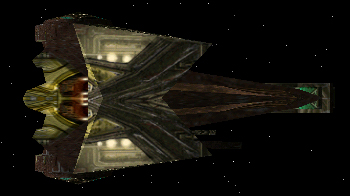King Snake class (SFC)
The Gorn Confederation's King Snake class destroyer (DD) first entered service in 2250, as well as the frigate (FF) variant. The DD was a powerful antagonist when built, carrying the heavy Type-G plasma torpedo. The class was designed with expansion in mind, which may indicate why the Gorn produced an obviously inadequate destroyer, which nevertheless made for a very good frigate. Both the DD and FF types had a crew complement of 120, a capacity of eight shuttlecraft, two science labs, two transporters, a single tractor beam emitter, and were armed with Type-1 phasers. The DD type was armed with the Type-G plasma torpedo, while the FF type was armed with the smaller Type-F plasma torpedo. The DD type remained in production until 2280. The limitations of the FF design quickly became apparent, however, and the FF+ variant was introduced soon after, with existing FF's being upgraded to the new specifications as quickly as possible. The FF+ specifications had slightly more powerful shields, as well as Type-3 phasers.
The commando transport destroyer (DDG) was introduced in 2258, and was designed as a consort to the Euromastyx class commando transport (COM). The DDG retained its Type-G plasma torpedo, which enabled it to also operate as a standard DD. The DDG also increased its crew capacity to 240, gained an additional transporter for offloading Marines, and remained in production until 2282.
2268 saw the introduction of the destroyer refit (DD+), which gave the class improved shielding, among other upgrades. The DD+ remained in production until 2298. These improvements were also passed along to the DDG, resulting in the DDG+ variant in 2270, which remained in production until 2305.
In one of several attempts to improve the underpowered destroyer design and produce a satisfactory ship for use as a squadron leader, the destroyer leader (DDL) variant was introduced in 2272. The DDL featured significantly stronger shields, an increased crew capacity of 240, three torpedo tubes with both Type-G and Type-F plasma torpedoes, but only Type-1 phasers. The DDL remained in production until 2296.
As the General War began, the Gorn began to develop two primary wartime construction classes, including the battle destroyer (BDD), which was introduced in 2275. The Gorn were able to save money by converting existing destroyer hulls in production to battle destroyers, as well as using existing destroyer production facilities for BDDs, which remained in production until 2303. Improvements to the class included a crew capacity of 240, even stronger shielding, as well as continuing the use of three torpedo tubes with a dual Type-G and F plasma torpedo payload, and Type-1 phasers.
The battle destroyer leader (BDL) was introduced in 2280, and was intended to provide a squadron leader for less than the cost of an Anaconda class heavy destroyer (HDD), but the experiment was not entirely successful from a financial standpoint, as HDDs were nevertheless cheaper to build and more effective in combat than the BDLs, given the limitations of the BDD design. The BDL had a crew capacity of 300, featured the strongest shields available for the class, in addition to the existing BDD specifications, and remained in production until 2298.
Two new variants were introduced in 2284: the improved destroyer leader (DDL+) and the commando battle destroyer (BDG). The DDL+ expanded on the DDL specifications by adding Type-3 phasers, improving the defensive capabilities of the type. The BDG was, essentially, a DDG upgraded with the BDD design, and carried a full battalion of Marines with somewhat improved support. It was not a fully capable BDD, but was still a formidable design for a commando ship. The BDG had a crew complement of 300, featured the standard BDD specifications, plus a total of four transporters, a single torpedo tube with a payload of Type-G plasma torpedoes, and Type-1 phasers. The BDG remained in production until 2305.
The basic destroyer design was upgraded again in 2286 with the fleet destroyer (DDF) variant. The DDF featured three torpedo tubes with a dual Type-G and Type-F plasma torpedo payload, and both Type-1 and Type-3 phasers. In 2289, the BDL variant saw an upgrade with the improved battle destroyer leader (BDL+) variant, which added Type-3 phasers to the design's armaments. This improvement was also reflected in the improved battle destroyer (BDD+) in 2291 and the improved battle commando destroyer (BDG+) in 2293.[1]
King Snake class vessels
SFC Timeline
G.C.S. Barb • G.C.S. Black Rhino • G.C.S. Blade • G.C.S. Bonecrusher • G.C.S. Claw • G.C.S. Coil • G.C.S. Double Thunder • G.C.S. Drago • G.C.S. Dragon's Breath • G.C.S. Dragon's Fire • G.C.S. Dragon's Heart • G.C.S. Dragonbane • G.C.S. Eradicator • G.C.S. Fafnir • G.C.S. Fang • G.C.S. Ferocious • G.C.S. Fire Lizard • G.C.S. Galaga • G.C.S. Grand Finale • G.C.S. Hero • G.C.S. Horn • G.C.S. Horned Rhino • G.C.S. Hunter • G.C.S. Iron Fang • G.C.S. Iron Hide • G.C.S. Iron Will • G.C.S. Jaws • G.C.S. Kalessin • G.C.S. Mercy Killer • G.C.S. Mortal Strike • G.C.S. Naja • G.C.S. One Time • G.C.S. Proven Slayer • G.C.S. Prowler • G.C.S. Ragged Rhino • G.C.S. Rajath • G.C.S. Rhino • G.C.S. Saurian • G.C.S. Scale • G.C.S. Serpent's Tooth • G.C.S. Shock Force • G.C.S. Smasher • G.C.S. Snarl • G.C.S. Spine • G.C.S. Spinecrusher • G.C.S. Spur • G.C.S. Steel Jaws • G.C.S. Sting • G.C.S. Strongarm • G.C.S. Talon • G.C.S. Thecos • G.C.S. Thorn • G.C.S. Thunderbolt • G.C.S. Tooth • G.C.S. Tusk • G.C.S. Ultimate Wrath • G.C.S. Vanquish Evil • G.C.S. Vanquish Invader • G.C.S. Vigorous • G.C.S. Whiplash • G.C.S. Whiptail • G.C.S. White Rhino • G.C.S. Wing • G.C.S. Wrathful Judge • G.C.S. Wyrm • G.C.S. Yevaud
Notes and References
- ↑ Bethke, Erik (Producer). Starfleet Command. Lead Designer: Erik Bethke. Senior Designer: Chris Taylor. Mission Scripting by Lance Watanabe. Campaign Mission Design by Scott Bennie. Game Design by Marc Hertogh and Tom Hughes. SFB Consultant: Tom Hughes. Interplay Inc.. 15 September 1999.

